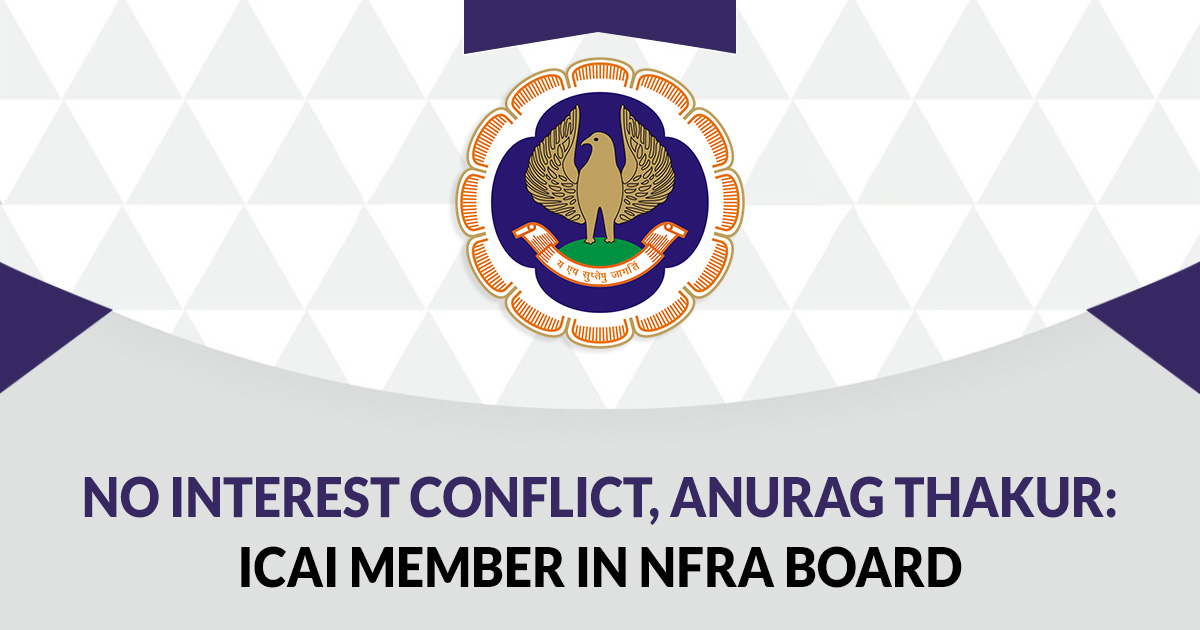
A written statement by Anurag Thakur, Minister of State for Finance and Corporate Affairs, was presented in Lok Sabha saying that the involvement of the ICAI member on the National Financial Reporting Authority (NFRA) Board will not create a conflict of interest situation.
Provided by the NFRA Rules 2018, the constitution of the NFRA Board has a total of 13 members out of which 3 are ICAI members. As mentioned under section 132(2) and (4), all the main activities will be performed under the surveillance of the main executive body thus avoiding conflict of interest.
MCA’s in Favour of Small Businesses
Ministry of Corporate Affairs (MCA) is constant on improving its regulatory structure, including the provisions in return filing which will lessen the burden of compliance from primarily small companies, One Person Companies and various start-ups.
By now several amendments have been introduced in the Companies Act serving the cause and more provisions will be incorporated from time to time owing to the changing needs of the companies in India. The Companies (Auditor’s Report) Order, 2016 (CARO, 2016) has not been extended to private schools and hospitals built on concession land.
As mentioned by the Securities and Exchange Board of India (SEBI) under the Ministry of Finance, the department has introduced measures to enhance the governance standards in rating agencies:
- Credit Rating Agencies (CRA) to segregate the activity other than the rating of financial instruments under the respective guidelines of a financial sector regulator or any authority as may be specified by SEBI.
- MD/CEO of CRA shall not be included among the members of the rating committees of CRA.
- Rating committees of CRA are required to report to the Chief Ratings Officer (CRO).
- One-Third of the CRA Board must involve independent directors if the head of the Board is a non-executive director. In case, if the Board is headed by the executive director then half of the Board is required to be of independent directors.
- CRA Board must include a Ratings Sub Committee and a Nomination and a Remuneration Committee.
- Chief Rating Officer (CRO) is responsible for reporting directly to the Rating Sub-Committee of the CRA Board.
- The Nomination and Remuneration Committee will be headed by an independent director.
- CRA shall conduct a meeting with the audit committee at least once a year, the main essence of the meeting will be party transactions, internal financial control and other material disclosures made by the management. This will have an effect on the rating of the listed Non-Convertible Debentures (NCDs).
- The applicant’s minimum net worth requirement has increased from Rs. 5 Crore to Rs. 25 Crore.
- The CRA promoter has to maintain a shareholding of 26% in the CRA for a minimum of 3 years starting from the date of registration assigned by the Board.
- A CRA is not eligible for any shareholding (directly or indirectly) of more than 10% or any voting rights of another CRA. A CRA shall not represent another CRA on the Board.
Adding on to the above amendments by SEBI, the following points have been added by the SEBI department in order to improve the corporate governance of listed entities:
- Rules monitoring corporate governance were introduced with Clause 49 on Feb 2000. Afterwards, Clause 49 was revised for more rigidity in 2004 with recommendations from Narayan Murthi Committee. It was in 2015 that clause 49 was again re-adjusted by SEBI and was introduced as SEBI Regulations 2015.
- SEBI initiated a committee under the supervision of Mr. Uday Kotak in June 2017. This committee was centred to enhance the corporate governance of the listed companies in India. The committee presented the reports to SEBI on October 2017.
- Paying heed to public comments and continuous meetings with several stakeholders, the recommendations by the Kotak committee were approved by SEBI Board and were included in the SEBI Regulations 2015 and finally notified on 09 May 2018.
Changes made according to the recommendations of the Kotak Committee were implemented in a phased manner. Some of these reforms are as follows:
- There has to be at least one woman independent director in the top 500 listed entities by market capitalization by 1 April 2019, and in the top 1000 listed entities, by 1 April 2020.
- Segregation of CEO/MD and the Chairperson, for now, applicable to the top 500 listed entities by market capitalization will be in effect from. April 1, 2020.
- Enhanced disclosure of related party transactions (RPTs) and related parties to be permitted to vote against RPTs.
- The maximum number of listed entity directorships will reduce from 10 to 8 by April 01, 2019 and to 7 by April 1, 2020.
- There are enhancements in the roles of the Audit Committee, Nomination and Remuneration Committee (NRC) and Risk Management Committee.
- Disclosures of auditor credentials, audit fee, reasons for the resignation of auditors, etc.
- Disclosure of expertise/ skills of directors.
- Mandatory disclosure of consolidated quarterly results w. e. f. Financial Year 2019-20. It is mandatory to conduct a Secretarial Audit for listed companies and their material unlisted subsidiaries.
- Minimum six directors in the top 1,000 listed entities by market capitalization by April 1, 2019, and in the top 2000 listed entities, by April 1, 2020.
- The majority of Board meetings (1/3rd of the composition of the Board or 3 members, whichever is higher) in the top 1000 listed entities by market capitalization by April 1, 2019, and in the top 2000 listed entities, by April 1, 2020.
- The top 100 companies are required to conduct an AGM within 5 months before the end of the FY 2018-19 (preferably by 31 August 2019).
- A video broadcast of the AGMs for the top 100 entities is mandatory by market capitalization.







